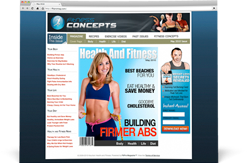Expand Your Personal Trainer Image from Fitness Expert to Local Fitness Icon
Posted by Steve Hochman on Mon. Nov. 17th, 2014
 The biggest and best names in the Fitness Industry (you know, the guys and girls whose names you always hear floating around the gym or popping up in your Facebook sidebar) are more than just teachers or workout experts. These iconic figures, who spend their time sitting atop the industry’s tallest mountains and making the biggest bucks, are way more than just personal trainers.
The biggest and best names in the Fitness Industry (you know, the guys and girls whose names you always hear floating around the gym or popping up in your Facebook sidebar) are more than just teachers or workout experts. These iconic figures, who spend their time sitting atop the industry’s tallest mountains and making the biggest bucks, are way more than just personal trainers.
Ever wondered how they reached such lofty heights? Sure, it has a lot to do with work ethic and personal situations and maybe a bit of luck, but there is one tool, one strategy that each of these giants uses to reach the tip-top of the Fitness Industry leaderboards.
Want to know what it is?
It’s storytelling.
Or, said differently, StorySelling.
Each of these greats has mastered the art of leveraging his or her personal origins and anecdotes to establish professional ethos (reputation) and, more importantly, make money from it.
O.K., let’s backtrack a little here and take a look at some examples.
Take, for instance, Jason Ferruggia. Jason is obviously an incredibly talented and knowledgeable teacher, author, and fitness expert. There is no doubt that his mastery and expertise are the driving forces contributing to his success. But there are certain tricks, strategies, and nuances that he uses to transform him from personal trainer to fitness celebrity.
Everyone knows Ferruggia for his incredible blog and his awesome products. He’s huge because he produces great content, but he’s a celebrity because people like, adore, and emulate him: his personality, his image, his story.
When you hear “Jason Ferruggia,” what sorts of thoughts and images immediately jump into your mind? Is it “Muscle Gaining Secrets?” Maybe you think of “The Renegate Diet?” Or, do you think hard ass, no B.S., straight shooting and hard-hitting writer, blogger, and fitness personality?
Thought so.
You see, Ferruggia doesn’t just have the awesome content and top-notch talent, he has created an image of himself that builds rapport, gains customer trust, and sells product through generating fascination and fandom within his audience.
Let’s take a look at a more understated example.
Craig Ballantyne is another huge name in Fitness and Online Fitness Products but doesn’t quite promote the same kind of ‘in your face’ personality. He does, however, use Storyselling just as much as Ferruggia.
Ballantyne is regularly telling his ‘origin story.’ He even has a series of videos that show his hometown, his parent’s house where he grew up, and all the places where he developed his original best-selling workout products.
Just like Ferruggia, Ballantyne is generating interest in his personal story to establish a certain, particular image. He says on his website that he is “just a good ol’ Canadian boy;” he wants his audience to identify with him, to relate to him, to build rapport with him and, you guessed it, BUY FROM HIM.
Now, don’t get me wrong, I’m not calling these guys out for being false or manipulative. Their stories are true and their images, while carefully presented, are accurate representations of who they are in their real, day-to-day lives. They are simply leveraging a valuable resource to increase the success of their businesses.
And you should too.
Once again, don’t get me wrong here. I’m not telling you that with a great sob story you’re going to skyrocket to the top and become the biggest, baddest, richest personal trainer in the country. But, while these strategies work great for the biggest names in the business, that doesn’t mean we small business owners can’t use the same techniques to find similar, if scaled down, success.
Do you think you are more likely to find new Boot Camp clients if you are known in your town as a great trainer, or if everyone looking for a gym in your city is talking about the stay at home mom who singlehandedly brought her family back form the brink of bankruptcy and poverty by creating a massively successful Fitness Boot Camp that helps hundreds of clients every month? Or maybe you are the successful trial lawyer turned expert personal trainer because your passion for health and helping people was too strong to stay in the courtroom?
The story itself really doesn’t matter, as long as it’s genuine and it uses a reasonable amount of drama to show how you got form where you used to be to the successful, knowledgeable, and likable expert you are today.
Alright, I know that coming up with a compelling story, and knowing how to use it effectively, is not as easy as I’m trying to make it sound. So, I have come up with the 5 best strategies for creating and telling your own hero story.
- The Main Character – Your story should be centered around the life and events of a main character, which, in your case, will most likely be you. You’re the owner of the Boot Camp, you’re the big-boss who calls all the shots, you’re the one everyone is interested and wants to know more about— or, at least you should be. Want to get everyone interested in you and dying to know all about you? Start telling your story.
- The Reluctant Hero – You’re not the best because you like to be seen as better then everyone else; you don’t call all the shots because you’re obsessed with power and like to push the little guy under your thumb. No, you take the lead and you have become the best because you’re passionate about helping people; even though, in reality, you’re just like everybody else.
- Lead with Your Faults – This goes right along with the theme of The Reluctant Hero: you’re just like every one of your customers. Start your story with all your faults, all your problems and all the mistakes you made that forced you to become successful and drove you to be the professional you are today. Allow individuals to identify with you and your life by continually reminding them that you are not perfect.

- Grab Attention – Your story needs to have an irresistible hook. Find a way to present yourself and your narrative in a way that builds interest and anticipation. It’s very helpful if you tell your story often. In fact, you should recount the tale every chance you get. You can even write the story down and periodically send sections of it out to your list. It’s O.K. if you start to sound repetitive; you want to be well known, you want everyone else to pass your story around so often that new clients can’t wait to hear it from you: the source, the star, the expert.
- Build Trust – This final point truly sums up everything that we are trying to accomplish with the Storyselling technique. In order for people to buy from you they need to Know, Like, and Trust you. Telling your story is the best way to do this but, this advise comes with a caveat: you absolutely must be GENUINE. People will see straight through you the moment you begin to lie or tell a tale that’s too tall. People aren’t stupid and it only takes milliseconds to spot a sleezy, used-car-salesmen pitch.
So, whether you are trying to attract more business to your Fit Body Boot Camp locations, or even if you have decided to try your hand at distributing an online information product to supplement your Boot Camp business, establish a reputation that builds trust through the telling of your personal story. I guarantee it will increase your satisfaction with your work, bring you more clients, sell more of your products, and make you more money.
Posted in Closing and Sales Techniques, Selling Personal Training, Uncategorized by |

